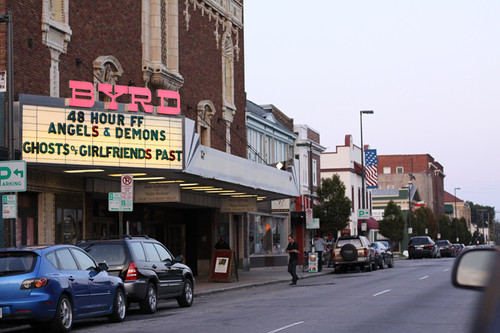Byrd Theatre, Carytown District, Richmond. Flickr photo by theloushe.
It's a struggle for independently owned movie theaters to be successful because of the way "rents" are paid on movie usage. For the first couple weeks of a run, almost all of the revenues--more than 90%--from tickets go to the movie company. That's why theaters push concessions (food and drink) and reduce personnel (a couple projectionists can run multiple theater rooms, etc.).
But those independent theaters that remain are often important anchors in traditional commercial districts and can be important anchors for arts districts.
While digital projection capabilities can add to revenue capabilities for some theaters, which can show
simulcasts of opera productions or be used for daytime business meetings, for other theaters the cost of adding digital equipment required by movie companies so that they can distribute movies "online" without having to provide analog prints isn't paired with opportunities to increase revenues--all the benefits go to the movie production companies.
Even second-run theaters like the Byrd in Richmond will need this kind of equipment, because the movie distribution companies won't be distributing analog prints.
When Sanford Hess started running a century-old movie theater two years ago, he knew Hollywood was replacing celluloid with digital files. But since the 250-seat venue in downtown Champaign, Ill., had already endured Betamax, VHS, Netflix, and a 15-year stretch showing porn, he figured it would survive this latest transition. Now he's not so sure.
The 12-employee business, which had just over $300,000 in revenue in 2011, can't afford the pricey new projector and other equipment major studios want him to buy. Unless he raises the money to pay for it by October, Hess says, he'll close the theater.This is an example of how exogenous changes within industries trickle down and negatively impact urbanity. Other such changes include the passage of the Public Utility Holding Company Act in 1935, which forced streetcar companies to disconnect from electric power generating companies (in the development of the electric power industry, their original main customers were industrial, and often started with electric streetcar companies) and the holding in United States v. Paramount Pictures, Inc., 334 US 131 (1948) which forbade vertical integration in the film industry, and required the companies to sell off their company-owned theaters--just as companies like Apple,Nike, and Sony have signature stores (of course, Apple stores are wildly profitable) to promote their brand and so the stores can be cross-subsidized, signature downtown movie theaters were part of the branding experience for the film companies and when that ownership was disconnected (not unjustifiably on anti-trust grounds), movie theaters in city centers and therefore the city centers and neighborhood commercial districts with active theaters lost out.
Labels: commercial district revitalization planning, theater-cinema, urban design/placemaking




0 Comments:
Post a Comment
<< Home